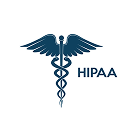Call Center Quality Assurance Metrics:
What They Are & How to Measure Them

Continuous improvement is key to keeping your call center competitive. However, how can you improve something that you can’t measure?
In this article, we’ll explore the topic of call center quality assurance, discuss the metrics that make it possible (and how to calculate them!), and provide the context necessary for motivating you to implement this best practice in your operations.
Key Takeaways:
- Call center quality assurance metrics measure various internal and external aspects of your operations, including productivity and customer satisfaction.
- Call center QA metrics are directly related to your company’s success, as they affect customer churn, loyalty, lifetime value, and revenue.
- Some of the most important call quality parameters include Average Handle Time, First-Call Resolution, the Net Promoter Score, and more.
What Are Call Center Quality Assurance Metrics?
Call center quality assurance metrics commonly refer to metrics and Key Performance Indicators (KPIs) that measure the quality and effectiveness of interactions between call center agents and customers on several levels.
Did You Know?
KPIs can consist of a single or multiple metrics. The difference between a KPI and a metric is based on whether they directly contribute to your company’s Objectives & Key Results (OKRs).
Companies often use specialized software to track call quality assurance and call center managers and supervisors are responsible for monitoring, measuring, interpreting, and optimizing metrics to maximize organizational efficiency.
This is vital for several reasons, as high-level call center quality contributes to increased customer satisfaction, lower customer churn, and better revenue in the long term, among many other benefits we’ll discuss later.
Measure and optimize your call quality metrics for 14 days completely free!
Top 6 Call Center Quality Assurance Metrics
There are numerous call quality metrics you can select as your KPIs. What matters is that whichever ones you choose are relevant to your organizational goals and that you are able to accurately track and measure them.
However, there are six metrics companies often choose to use due to their significant effect on overall call center performance. These include:
Average Speed of Answer (ASA)
As the name suggests, ASA is a measure of how quickly your agents pick up a customer’s call after the phone rings in an inbound setting. This metric is highly important due to its direct effect on customer satisfaction and perceived quality.
Global Average: 34.4 seconds
How to Calculate:
- Measure Total Waiting Time: To measure ASA, use your call center system’s Analytics or schedule an ASA test period. Track the wait times for all incoming calls, accounting only for the time the phone is actually ringing.
- Measure Total Number of Answered Calls: Since missed calls are not relevant to the ASA metrics, you should only work with information from calls that were successfully answered by an agent.
- Calculate Average Speed of Answer: To find out how long it takes your agents to answer a call on average, divide the total waiting time of all calls by the total number of all answered calls in the period.
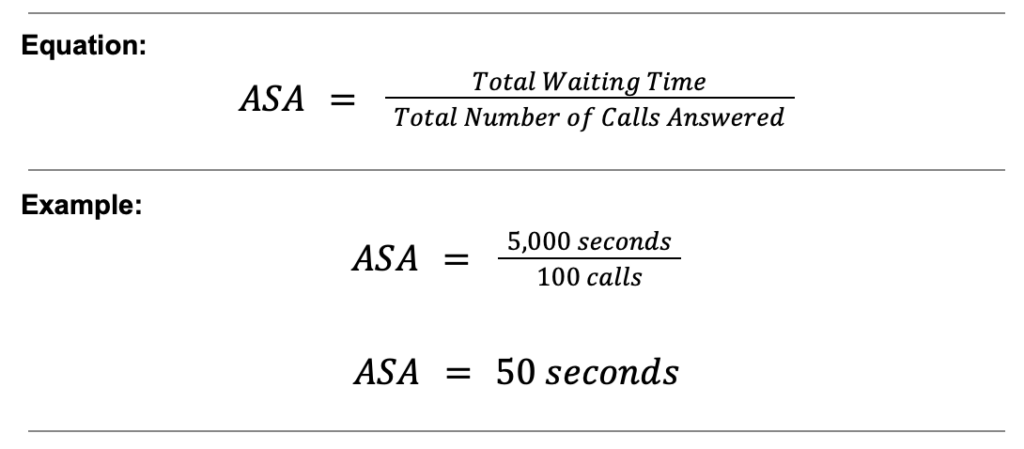
First-Call Resolution (FCR)
FCR is the percentage of incoming calls resolved during the first interaction with a support agent without the need for escalation or follow-up. FCR is an indicator of customer satisfaction and operational efficiency.
Global Average: 70% – 75%
How to Calculate:
- Identify Resolved Issues: Determine the number of calls where the customer’s issue was completely resolved during the first interaction without needing further action, such as callbacks or follow-ups from the customer.
- Measure Total Number of First Calls: Count the total number of first-time calls related to customer issues or inquiries during the measurement period and disregard any follow-up calls connected to existing tickets.
- Calculate First-Call Resolution: To find out the percentage of your success in resolving customer issues on the first call, divide the number of resolved issues by the total number of first calls and multiply the result by 100.
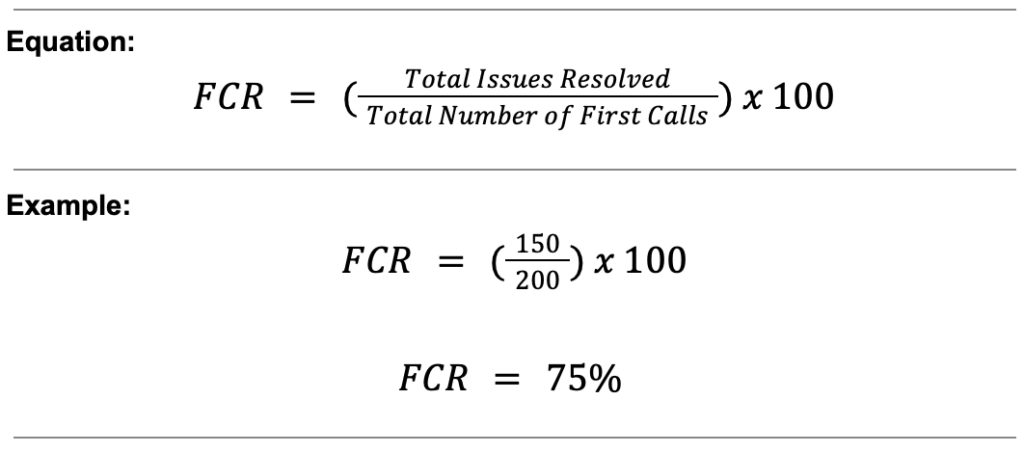
Average Handle Time (AHT)
AHT refers to the average duration of incoming calls, from when they are answered by a support agent to when they are completed. AHT measures the efficiency of support interactions and helps identify opportunities for streamlining processes.
Global Average: 6 minutes
How to Calculate:
- Measure Total Talk Time: Calculate the total time agents spend talking to customers during calls. This includes the time from when the call is answered to when it ends.
- Measure Total Hold Time: Add up the total time customers are placed on hold during calls. Hold time is typically used when agents need to consult resources or other team members.
- Measure Total After-Call Work (ACW): Include the time agents spend completing tasks related to the call after it ends, such as updating records, sending follow-up emails, or logging details into the system.
- Measure Total Number of Calls: Determine the total number of calls handled during the period being measured.
- Calculate Average Handle Time: Combine the total talk time, hold time, and after-call work time, then divide by the total number of calls handled.

Customer Satisfaction Score (CSAT)
CSAT is used to measure customer satisfaction with the support experience, typically collected through post-call surveys or feedback mechanisms. CSAT scores provide insights into the quality of support interactions and overall service delivery.
Global Average: 75% – 80%
How to Calculate:
- Send Out Surveys or Ask for Feedback: It is common to ask customers to rate their satisfaction with a specific interaction or overall experience on a scale from 1 to 10, going from “very unsatisfied” to “completely satisfied”.
- Calculate Customer Satisfaction: Once you have a sufficient number of answers, calculate the CSAT score by taking the percentage of customers who rated their experience as satisfactory (often the top two ratings on the scale).
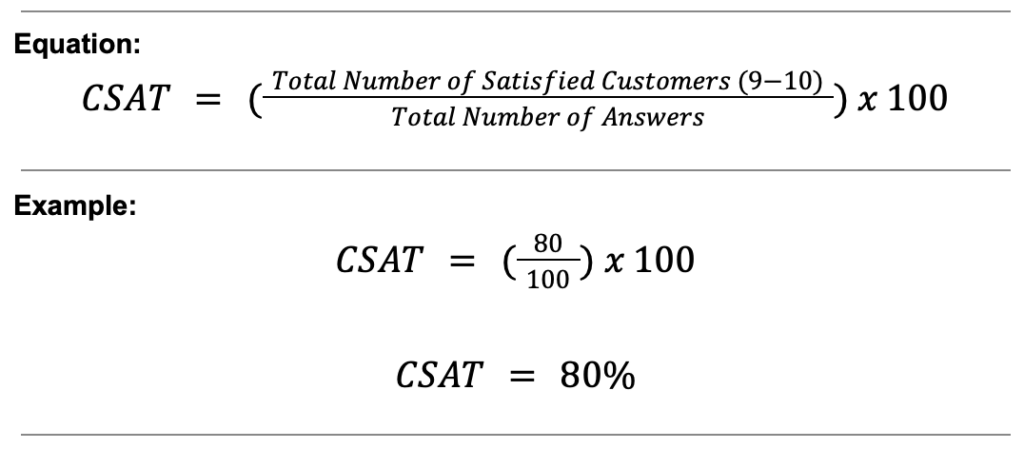
Net Promoter Score (NPS)
NPS is a widely used metric that measures customer loyalty and their likelihood of recommending a company, product, or service to others. NPS is a powerful indicator of overall customer satisfaction and future business growth.
Global Average: +44
How to Calculate:
- Survey Net Promoter Score: The NPS is typically measured by asking customers a single question: “On a scale of 0 to 10, how likely are you to recommend our company/product/service to a friend or colleague?”.
- Categorize Respondents: Customers who answer 9 – 10 are marked as “promoters”, 7 – 8 are called “passives”, and 0 – 6 can be categorized as “detractors”. You will mostly care about the two extremes.
- Calculate Net Promoter Score: To calculate the NPS, subtract the percentage of detractors from the percentage of promoters, as passive customers do little to contribute towards your company’s reputation either way.
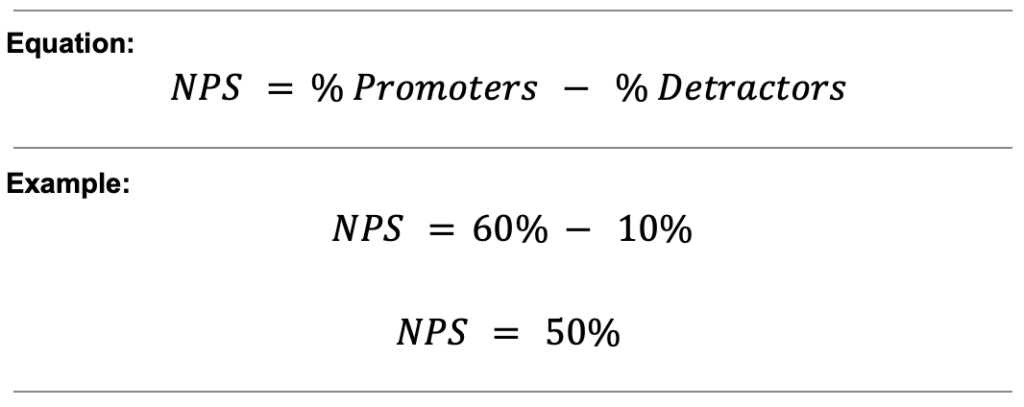
Customer Effort Score (CES)
CES measures how easy it is for customers to interact with a company and resolve their issues. It focuses on the effort a customer must exert to achieve their desired outcome. CES is critical in improving satisfaction and loyalty, as well as lowering churn rates.
Global Average: 5
How to Calculate:
- Survey Customer Effort: This is typically measured by asking customers a simple question after an interaction, such as: “On a scale of 1 to 7, how easy was it to resolve your issue today?”
- Calculate Customer Effort: The CES is calculated by averaging the scores given by customers. The higher the average score, the more customer-friendly is your company.

Benefits of Tracking Call Center Quality Assurance
We’ve touched on the value of tracking call quality parameters throughout the previous sections, but to remove any doubts, let’s expand on what makes the extra effort worth it. The main benefits of tracking call center QA include:
- Improved Customer Satisfaction: Monitoring metrics like First Call Resolution (FCR) and Customer Satisfaction (CSAT) ensures that customer issues are resolved promptly and effectively, leading to higher satisfaction and loyalty.
- Enhanced Agent Performance: Quality assurance metrics identify areas where agents excel or need improvement, enabling targeted training and coaching to boost overall performance and consistency.
- Increased Operational Efficiency: By analyzing metrics such as Average Handle Time (AHT) and Average Speed of Answer (ASA), call centers can streamline processes, reduce wait times, and optimize resource allocation.
- Better Decision-Making: Data-driven insights from quality assurance metrics help managers make informed decisions on staffing, training, and process improvements, aligning operations with business goals.
- Higher Compliance and Consistency: Regular tracking of quality metrics ensures that agents adhere to company policies and industry regulations, leading to more consistent service delivery and reduced risk of compliance issues.
Discover how CloudTalk helps you deliver the highest quality experiences!
Best Practices for Improving Quality Assurance Metrics
Effectively tracking call center quality assurance metrics demands a significant amount of extra effort, though it is well worth it. To make sure you get the best out of call center QA without too much trouble, make sure to follow these best practices:
- Set Clear Objectives: Define specific goals for each metric you track, such as improving First Call Resolution (FCR) or reducing Average Handle Time (AHT). Clear objectives help focus efforts and measure success accurately.
- Use a Balanced Scorecard: Monitor a mix of metrics that cover different aspects of performance. This ensures a comprehensive view of your call center’s effectiveness and helps not overlook any room for improvement.
- Regularly Review and Update Metrics: Continuously assess the relevance of your metrics to ensure they align with evolving business goals and customer needs. Regular updates help keep your quality assurance process effective.
- Incorporate Customer Feedback: Use customer feedback to validate and enhance your quality assurance metrics. Integrating CSAT or Net Promoter Score (NPS) data provides a deeper understanding of customer experiences.
- Leverage Advanced Call Center Software: AI-powered call center software like CloudTalk can provide companies with advanced analytics and reporting features to streamline QA, simplify identifying trends, and help with decision-making.
Challenges in Measuring Call Center Quality Assurance
Tracking call center quality assurance metrics is essential for maintaining high service standards, but it comes with several challenges. These obstacles can complicate the measurement process and impact the accuracy and effectiveness of the metrics.
- Subjective Evaluations: Quality assessments often rely on human judgment, which can introduce bias and inconsistency. Ensuring uniformity across evaluations is a constant challenge.
- Data Overload: With numerous metrics to track, sorting through vast amounts of data can be overwhelming. Identifying which metrics are most relevant and actionable requires careful consideration.
- Balancing Speed and Quality: Focusing too much on efficiency metrics like Average Handle Time (AHT) can lead to rushed interactions, potentially compromising the quality of service and customer satisfaction.
- Keeping Up with Changing Expectations: Customer expectations and business goals evolve over time, making it challenging to keep quality assurance metrics aligned with current needs.
- Ensuring Agent Buy-In: Agents may resist quality assurance initiatives if they feel micromanaged. Gaining their buy-in requires transparent communication and a focus on continuous improvement rather than punishment.
Ready to Reach New Levels of Effectivity?
Call center quality assurance is a crucial aspect of any well-optimized company’s inbound and outbound call operations. It largely contributes to both internal and external performance, ensuring agents’ productivity and customers’ satisfaction.
And now that you’re armed with the knowledge of how to calculate the most important and common call center quality assurance metrics, there’s only one thing to do. Start measuring and stay effective!
Discover how CloudTalk can transform your calling experience!
FAQs
What is a QA scorecard for a call center?
A QA scorecard for a call center is a tool used to evaluate and measure the performance of call center agents during customer interactions. It outlines specific criteria that align with the company’s quality standards, such as communication skills, adherence to scripts, issue resolution, and customer satisfaction.
Each interaction is scored against these criteria, providing a structured way to assess agent performance, identify training needs, and ensure consistent service delivery.
How to measure quality in a call center?
Quality in a call center is measured through a combination of quantitative and qualitative metrics. Key methods include:
Monitoring Calls: Reviewing and scoring live or recorded calls against predefined criteria on a QA scorecard.
Customer Feedback: Gathering direct feedback from customers through surveys, such as Customer Satisfaction (CSAT) or Net Promoter Score (NPS).
Tracking Key Metrics: Measuring performance through metrics like First Call Resolution (FCR), Average Handle Time (AHT), and Customer Effort Score (CES).
Regular Audits: Conducting periodic audits of processes and interactions to ensure compliance with quality standards.
What is the role of QA in a call center?
The role of Quality Assurance (QA) in a call center is to ensure that customer interactions meet the company’s standards for service quality. QA teams monitor and evaluate agent performance, provide feedback and training, and implement processes that drive continuous improvement.
QA helps maintain consistency in customer service, enhances customer satisfaction, and ensures that agents are equipped to handle a wide range of customer issues effectively.
What are the key metrics of a call center?
Key metrics of a call center include:
First Call Resolution (FCR): The percentage of customer issues resolved on the first call without the need for follow-ups.
Average Handle Time (AHT): The average duration of a call, including talk time, hold time, and after-call work.
Customer Satisfaction (CSAT): A measure of how satisfied customers are with their interaction or the service received.
Net Promoter Score (NPS): A metric that assesses customer loyalty and their likelihood of recommending the company to others.
Average Speed of Answer (ASA): The average time it takes for an agent to answer a customer call, indicating how quickly customers are attended to.




















